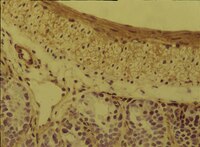NEDD9 stabilizes focal adhesions, increases binding to the extra-cellular matrix and differentially effects 2D versus 3D cell migration.
Zhong, J; Baquiran, JB; Bonakdar, N; Lees, J; Ching, YW; Pugacheva, E; Fabry, B; O'Neill, GM
PloS one
7
e35058
2011
Mostrar resumen
The speed of cell migration on 2-dimensional (2D) surfaces is determined by the rate of assembly and disassembly of clustered integrin receptors known as focal adhesions. Different modes of cell migration that have been described in 3D environments are distinguished by their dependence on integrin-mediated interactions with the extra-cellular matrix. In particular, the mesenchymal invasion mode is the most dependent on focal adhesion dynamics. The focal adhesion protein NEDD9 is a key signalling intermediary in mesenchymal cell migration, however whether NEDD9 plays a role in regulating focal adhesion dynamics has not previously been reported. As NEDD9 effects on 2D migration speed appear to depend on the cell type examined, in the present study we have used mouse embryo fibroblasts (MEFs) from mice in which the NEDD9 gene has been depleted (NEDD9 -/- MEFs). This allows comparison with effects of other focal adhesion proteins that have previously been demonstrated using MEFs. We show that focal adhesion disassembly rates are increased in the absence of NEDD9 expression and this is correlated with increased paxillin phosphorylation at focal adhesions. NEDD9-/- MEFs have increased rates of migration on 2D surfaces, but conversely, migration of these cells is significantly reduced in 3D collagen gels. Importantly we show that myosin light chain kinase is activated in 3D in the absence of NEDD9 and is conversely inhibited in 2D cultures. Measurement of adhesion strength reveals that NEDD9-/- MEFs have decreased adhesion to fibronectin, despite upregulated α5β1 fibronectin receptor expression. We find that β1 integrin activation is significantly suppressed in the NEDD9-/-, suggesting that in the absence of NEDD9 there is decreased integrin receptor activation. Collectively our data suggest that NEDD9 may promote 3D cell migration by slowing focal adhesion disassembly, promoting integrin receptor activation and increasing adhesion force to the ECM. | 22509381
 |
Integrin adhesion and force coupling are independently regulated by localized PtdIns(4,5)2 synthesis.
Legate, KR; Takahashi, S; Bonakdar, N; Fabry, B; Boettiger, D; Zent, R; Fässler, R
The EMBO journal
30
4539-53
2010
Mostrar resumen
The 90-kDa isoform of the lipid kinase PIP kinase Type I γ (PIPKIγ) localizes to focal adhesions (FAs), where it provides a local source of phosphatidylinositol 4,5-bisphosphate (PtdIns(4,5)P(2)). Although PtdIns(4,5)P(2) regulates the function of several FA-associated molecules, the role of the FA-specific pool of PtdIns(4,5)P(2) is not known. We report that the genetic ablation of PIPKIγ specifically from FAs results in defective integrin-mediated adhesion and force coupling. Adhesion defects in cells deficient in FAPtdIns(4,5)P(2) synthesis are corrected within minutes while integrin-actin force coupling remains defective over a longer period. Talin and vinculin, but not kindlin, are less efficiently recruited to new adhesions in these cells. These data demonstrate that the specific depletion of PtdIns(4,5)P(2) from FAs temporally separates integrin-ligand binding from integrin-actin force coupling by regulating talin and vinculin recruitment. Furthermore, it suggests that force coupling relies heavily on locally generated PtdIns(4,5)P(2) rather than bulk membrane PtdIns(4,5)P(2). | 21926969
 |
Invasion of eukaryotic cells by Borrelia burgdorferi requires β(1) integrins and Src kinase activity.
Wu, J; Weening, EH; Faske, JB; Höök, M; Skare, JT
Infection and immunity
79
1338-48
2010
Mostrar resumen
Lyme disease, caused by the bacterium Borrelia burgdorferi, is the most widespread tick-borne infection in the northern hemisphere that results in a multistage disorder with concomitant pathology, including arthritis. During late-stage experimental infection in mice, B. burgdorferi evades the adaptive immune response despite the presence of borrelia-specific bactericidal antibodies. In this study we asked whether B. burgdorferi could invade fibroblasts or endothelial cells as a mechanism to model the avoidance from humorally based clearance. A variation of the gentamicin protection assay, coupled with the detection of borrelial transcripts following gentamicin treatment, indicated that a portion of B. burgdorferi cells were protected in the short term from antibiotic killing due to their ability to invade cultured mammalian cells. Long-term coculture of B. burgdorferi with primary human fibroblasts provided additional support for intracellular protection. Furthermore, decreased invasion of B. burgdorferi in murine fibroblasts that do not synthesize the β(1) integrin subunit was observed, indicating that β(1)-containing integrins are required for optimal borrelial invasion. However, β(1)-dependent invasion did not require either the α(5)β(1) integrin or the borrelial fibronectin-binding protein BBK32. The internalization of B. burgdorferi was inhibited by cytochalasin D and PP2, suggesting that B. burgdorferi invasion required the reorganization of actin filaments and Src family kinases (SFK), respectively. Taken together, these results suggest that B. burgdorferi can invade and retain viability in nonphagocytic cells in a process that may, in part, help to explain the phenotype observed in untreated experimental infection. Artículo Texto completo | 21173306
 |












